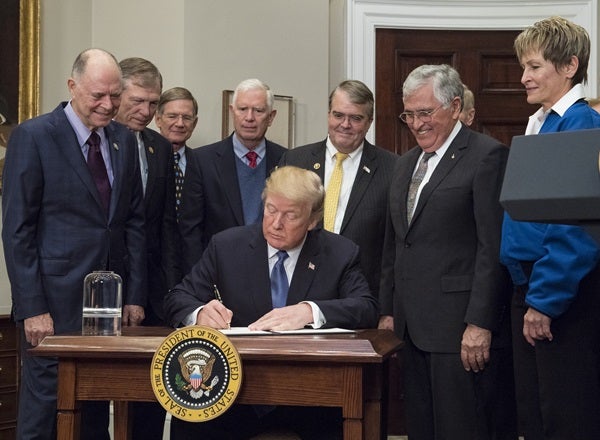President Trump signed a policy on Monday that will put human footprints on the Moon once again.
The mission of White House Space Policy Directive 1 is to create a U.S.-led space program that incorporates the efforts of government, international, and private space flight industries. The policy places an emphasis on getting astronauts back to the Moon, and includes the possibility of future manned-missions to Mars and beyond. The policy relies on NASA to “lead an innovative and sustainable program of exploration with commercial and international partners to enable human expansion across the solar system and to bring back to Earth new knowledge and opportunities.”
“The directive I am signing today will refocus America’s space program on human exploration and discovery,” said President Trump in a press release. “It marks a first step in returning American astronauts to the Moon for the first time since 1972, for long-term exploration and use. This time, we will not only plant our flag and leave our footprints — we will establish a foundation for an eventual mission to Mars, and perhaps someday, to many worlds beyond.”
The policy stems heavily from suggestions made by the National Space Council, an organization that was previously halted but brought back to life by the president in July. He reinstated the council, chaired by Vice President Mike Pence, to help direct and carry out plans to expand space exploration, which he touts as a national priority.
“NASA looks forward to supporting the president’s directive strategically aligning our work to return humans to the Moon, travel to Mars and opening the deeper solar system beyond,” said Robert Lightfoot, NASA’s acting administrator.
“This work represents a national effort on many fronts, with America leading the way.” Lightfoot said. “We will engage the best and brightest across government and private industry and our partners across the world to reach new milestones in human achievement. Our workforce is committed to this effort, and even now we are developing a flexible deep space infrastructure to support a steady cadence of increasingly complex missions that strengthens American leadership in the boundless frontier of space. The next generation will dream even bigger and reach higher as we launch challenging new missions, and make new discoveries and technological breakthroughs on this dynamic path.”
An impressive group of NASA astronauts attended the signing to support the policy’s implementation, including Buzz Aldrin, Christina Koch, Sen. Harrison “Jack” Schmitt, and Peggy Whitson. The ceremony was held on the 45th anniversary of NASA’s Apollo 17 Moon landing, with the document being signed on the exact minute that the mission landed. It was the last Apollo mission to have reached our celestial neighbor, with Schmitt being the most recent living astronaut to have walked on the Moon.
Although NASA’s budget for the fiscal year of 2019 is still in limbo, if approved, it may not be long before we send astronauts deeper into space than we have in the past 45 years.










